Analysis of the Nexus of CO2 Emissions, Economic Growth, Land under Cereal Crops and Agriculture Value-Added in Pakistan Using an ARDL Approach
Abstract
1. Introduction
2. Literature Review
3. Methodology and Data Collection
3.1. Data Sources and Description
3.2. Econometric Model
4. Results and Discussions
4.1. Descriptive Analysis and Correlation Matrix
4.2. Lag Selection for Vector Error Correction Model
4.3. Unit Root Test
4.4. Johansen Co-Integration Test
4.5. Autoregressive Distributed Lag (ARDL) Bound Testing of Co-Integration
4.6. Short-Run and Long-Run Equation Models
4.7. Diagnostic Test
4.8. Pairwise Granger Causality Tests
4.9. Impulse Response and Variance Decomposition Analysis
5. Conclusions and Policy Recommendations
Author Contributions
Funding
Acknowledgments
Conflicts of Interest
References
- FAO. The State of Food Insecurity in the World the Multiple Dimensions of Food Security; Food and Agriculture Organization of the United Nations: Rome, Italy, 2013. [Google Scholar]
- Boko, M.; Niang, I.; Nyong, A.; Vogel, A.; Githeko, A.; Medany, M.; Osman-Elasha, B.; Tabo, R.; Yanda Pius, Z. Africa, Climate Change 2007: Impacts, Adaptation and Vulnerability: Contribution of Working Group II to the Fourth Assessment Report of the Intergovernmental Panel on Climate Change; Cambridge University Press: Cambridge, UK, 2007; pp. 433–467. [Google Scholar]
- Turner, A.G.; Annamalai, H. Climate change and the South Asian summer monsoon. Nat. Clim. Chang. 2012, 2, 587–595. [Google Scholar] [CrossRef]
- Deressa, T.T.; Hassan, R.M.; Ringler, C. Perception of and adaptation to climate change by farmers in the Nile basin of Ethiopia. J. Agric. Sci. 2011, 149, 23–31. [Google Scholar] [CrossRef]
- Fatuase, A.; Ajibefun, I. Perception and Adaptation to Climate Change among Farmers in Selected Communities of Ekiti State, Nigeria. Gaziosmanpasa Univ. Ziraat Fak. Derg. 2014, 31, 101–114. [Google Scholar]
- Gömann, H. How Much did Extreme Weather Events Impact Wheat Yields in Germany?—A Regionally Differentiated Analysis on the Farm Level. Procedia Environ. Sci. 2015, 29, 119–120. [Google Scholar] [CrossRef][Green Version]
- Kurukulasuriya, P.; Mendelsohn, R.; Hassan, R.; Benhin, J.; Deressa, T.; Diop, M.; Eid, H.M.; Fosu, K.Y.; Gbetibouo, G.; Jain, S.; et al. Will African agriculture survive climate change? World Bank Econ. Rev. 2006, 20, 367–388. [Google Scholar] [CrossRef]
- Özdoǧan, M. Modeling the impacts of climate change on wheat yields in Northwestern Turkey. Agric. Ecosyst. Environ. 2011, 141, 1–12. [Google Scholar] [CrossRef]
- Potgieter, A.; Meinke, H.; Doherty, A.; Sadras, V.O.; Hammer, G.; Crimp, S.; Rodriguez, D. Spatial impact of projected changes in rainfall and temperature on wheat yields in Australia. Clim. Chang. 2013, 117, 163–179. [Google Scholar] [CrossRef]
- Song, T.; Zheng, T.; Tong, L. An empirical test of the environmental Kuznets curve in China: A panel cointegration approach. China Econ. Rev. 2008, 19, 381–392. [Google Scholar] [CrossRef]
- Tao, F.; Yokozawa, M.; Xu, Y.; Hayashi, Y.; Zhang, Z. Climate changes and trends in phenology and yields of field crops in China, 1981–2000. Agric. For. Meteorol. 2006, 138, 82–92. [Google Scholar] [CrossRef]
- Tao, F.; Zhang, S.; Zhang, Z. Spatiotemporal changes of wheat phenology in China under the effects of temperature, day length and cultivar thermal characteristics. Eur. J. Agron. 2012, 43, 201–212. [Google Scholar] [CrossRef]
- Tao, F.; Zhang, Z.; Xiao, D.P.; Zhang, S.; Rötter, R.P.; Shi, W.J.; Liu, Y.J.; Wang, M.; Liu, F.S.; Zhang, H. Responses of wheat growth and yield to climate change in different climate zones of China, 1981–2009. Agric. For. Meteorol. 2014, 189–190, 91–104. [Google Scholar] [CrossRef]
- Webb, L.B.; Whetton, P.H.; Barlow, E.W.R. Climate change and winegrape quality in Australia. Clim. Res. 2008, 36, 99–111. [Google Scholar] [CrossRef]
- You, L.; Rosegrant, M.W.; Wood, S.; Sun, D. Impact of growing season temperature on wheat productivity in China. Agric. For. Meteorol. 2009, 149, 1009–1014. [Google Scholar] [CrossRef]
- Ahmad, M.; Farooq, U. The state of food security in Pakistan: Future challenges and coping strategies. Pak. Dev. Rev. 2010, 49, 903–923. [Google Scholar] [CrossRef]
- Kang, Y.; Khan, S.; Ma, X. Climate change impacts on crop yield, crop water productivity and food security—A review. Prog. Nat. Sci. 2009, 19, 1665–1674. [Google Scholar] [CrossRef]
- IPCC. Climate Change 2014: Synthesis Report. Contribution of Working Groups I, II and III to the Fifth Assessment Report of the Intergovernmental Panel on Climate Change; IPCC: Geneva, Switzerland, 2014.
- Stocker, T.F.; Qin, D.; Plattner, G.K.; Tignor, M.M.B.; Allen, S.K.; Boschung, J.; Nauels, A.; Xia, Y.; Bex, V.; Midgley, P.M. IPCC, 2013: Climate Change 2013: The Physical Science Basis. Contribution of Working Group I to the Fifth Assessment Report of the Intergovernmental Panel on Climate Change; IPCC: Geneva, Switzerland, 2013; p. 1535. [Google Scholar]
- Gorst, A.; Groom, B.; Dehlavi, A. Crop Productivity and Adaptation to Climate Change in Pakistan Centre for Climate Change. Environ. Dev. Econom. 2018, 23, 1–23. [Google Scholar] [CrossRef]
- Sönke, K.; Eckstein, D.; Dorsch, L.; Fischer, L. Global Climate Risk Index 2016: Who Suffers most from Extreme Weather Events? Weather-Related Loss Events in 2014 and 1995 to 2014; Report from Germanwatch; Germanwatch: Bonn, Germany, 2015; pp. 1–28. Available online: https://germanwatch.org/sites/germanwatch.org/files/publication/16411.pdf (accessed on 30 October 2019).
- Abid, M.; Scheffran, J.; Schneider, U.A.; Ashfaq, M. Farmers’ perceptions of and adaptation strategies to climate change and their determinants: The case of Punjab province, Pakistan. Earth Syst. Dyn. 2015, 6, 225–243. [Google Scholar] [CrossRef]
- Tunç, G.I.; Türüt-Aşık, S.; Akbostancı, E. A decomposition analysis of CO2 emissions from energy use: Turkish case. Energy Policy 2009, 37, 4689–4699. [Google Scholar] [CrossRef]
- Sarkar, M.S.K.; Sadeka, S.; Sikdar, M.M.H.; Zaman, B. Energy Consumption And CO2 Emission In Bangladesh: Trends And Policy. Asia Pac. J. Energy Environ. 2015, 2, 175–182. [Google Scholar] [CrossRef]
- Appiah, K.; Dua, J.; Boamah, K.B. The Effect of Environmental Performance on Firm’s Performance—Evidence from Ghana. Br. J. Interdiscip. Res. 2017, 8, 340–348. [Google Scholar]
- Appiah, K.; Du, J.; Musah, A.A.I.; Afriyie, S. Investigation of the Relationship between Economic Growth and Carbon Dioxide (CO2) Emissions as Economic Structure Changes: Evidence from Ghana. Resour. Environ. 2017, 7, 160–167. [Google Scholar]
- McAusland, C. Globalisation’s Direct and Indirect Effects on the Environment. Glob. Transp. Environ. 2010, 31–53. [Google Scholar] [CrossRef]
- Adom, P.K.; Bekoe, W.; Amuakwa-mensah, F.; Mensah, J.T.; Botchway, E. Carbon dioxide emissions, economic growth, industrial structure, and technical efficiency: Empirical evidence from Ghana, Senegal, and Morocco on the causal dynamics. Energy 2012, 47, 314–325. [Google Scholar] [CrossRef]
- Asumadu-Sarkodie, S.; Owusu, P.A. The relationship between carbon dioxide and agriculture in Ghana: A comparison of VECM and ARDL model. Environ. Sci. Pollut. Res. 2016, 23, 10968–10982. [Google Scholar] [CrossRef] [PubMed]
- Shahbaz, M.; Khan, S.; Ali, A.; Bhattacharya, M. The impact of globalization on CO2 emissions in china. Singap. Econ. Rev. 2017, 62, 929–957. [Google Scholar] [CrossRef]
- Pesaran, M.H.; Shin, Y. An autoregressive distributed-lag modelling approach to cointegration analysis. Econom. Soc. Monogr. 1998, 31, 371–413. [Google Scholar]
- Gokmenoglu, K.K.; Taspinar, N. Testing the agriculture-induced EKC hypothesis: The case of Pakistan. Environ. Sci. Pollut. Res. 2018, 25, 22829–22841. [Google Scholar] [CrossRef]
- Liu, X.; Zhang, S.; Bae, J. The impact of renewable energy and agriculture on carbon dioxide emissions: Investigating the environmental Kuznets curve in four selected ASEAN countries. J. Clean. Prod. 2017, 164, 1239–1247. [Google Scholar] [CrossRef]
- Asumadu-sarkodie, S.; Owusu, P.A.; Asumadu-sarkodie, S.; Owusu, P.A. Carbon dioxide emission, electricity consumption, industrialization, and economic growth nexus: The Beninese case. Energy Sources Part B Econ. Plan. Policy 2016, 11, 1089–1096. [Google Scholar] [CrossRef]
- Asumadu-Sarkodie, S. Carbon dioxide emissions, GDP, energy use, and population growth: A multivariate and causality analysis for Ghana, 1971–2013. Environ. Sci. Pollut. Res. 2016, 23, 13508–13520. [Google Scholar] [CrossRef]
- Zhang, L.; Pang, J.; Chen, X.; Lu, Z. Carbon emissions, energy consumption and economic growth: Evidence from the agricultural sector of China’s main grain-producing areas. Sci. Total Environ. 2019, 665, 1017–1025. [Google Scholar] [CrossRef] [PubMed]
- Zafeiriou, E.; Azam, M. CO2 emissions and economic performance in EU agriculture: Some evidence from Mediterranean countries. Ecol. Indic. 2017, 81, 104–114. [Google Scholar] [CrossRef]
- Gornall, J.; Betts, R.; Burke, E.; Clark, R.; Camp, J.; Willett, K.; Wiltshire, A. Implications of climate change for agricultural productivity in the early twenty-first century. Philos. Trans. R. Soc. B. Biol. Sci. 2010, 365, 2973–2989. [Google Scholar] [CrossRef] [PubMed]
- Victor, P.A. Growth, degrowth and climate change: A scenario analysis. Ecol. Econ. 2012, 84, 206–212. [Google Scholar] [CrossRef]
- Barrios, S.; Ouattara, B.; Strobl, E. The impact of climatic change on agricultural production: Is it different for Africa? Food Policy 2008, 33, 287–298. [Google Scholar] [CrossRef]
- Ayinde, O.E.; Muchie, M.; Olatunji, G.B. Effect of Climate Change on Agricultural Productivity in Nigeria: A Co-integration Model Approach. J. Hum. Ecol. 2011, 35, 189–194. [Google Scholar] [CrossRef]
- Chen, J.; Cheng, S.; Song, M. Changes in energy-related carbon dioxide emissions of the agricultural sector in China from 2005 to 2013. Renew. Sustain. Energy Rev. 2018, 94, 748–761. [Google Scholar] [CrossRef]
- Goklany, I.M. Integrated strategies to reduce vulnerability and advance adaptation, mitigation, and sustainable development. Mitig. Adapt. Strateg. Glob. Chang. 2007, 12, 755–786. [Google Scholar] [CrossRef]
- Tol, R.S.J.; Downing, T.E.; Kuik, O.J.; Smith, J.B. Distributional aspects of climate change impacts. Glob. Environ. Chang. 2004, 14, 259–272. [Google Scholar] [CrossRef]
- Li, W.; Ou, Q.; Chen, Y. Decomposition of China’s CO2 emissions from agriculture utilizing an improved Kaya identity. Environ. Sci. Pollut. Res. 2014, 21, 13000–13006. [Google Scholar] [CrossRef]
- Ismael, M.; Srouji, F.; Boutabba, M.A. Agricultural technologies and carbon emissions: Evidence from Jordanian economy. Environ. Sci. Pollut. Res. 2018, 25, 10867–10877. [Google Scholar] [CrossRef] [PubMed]
- Dickey, D.A.; Fuller, W.A. Likelihood Ratio Statistics For Autoregressive Time Series With A Unit. Econometrica 1981, 49, 1057–1072. [Google Scholar] [CrossRef]
- Phillips, P.; Perron, P. Testing for a unit root in time series regression. Biometrika 1988, 75, 335–346. [Google Scholar] [CrossRef]
- Akalke, H. A New Look at the Statistical Model Identification. IEEE Trans. Autom. Control 1974, 19, 716–723. [Google Scholar]
- Schwarz, G. Institute of Mathematical Statistics is collaborating with JSTOR to digitize, preserve, and extend access to The Annals of Statistics. Ann. Stat. 1978, 6, 461–464. [Google Scholar] [CrossRef]
- Khim, V.; Liew, S. Which Lag Length Selection Criteria Should We Employ? Econ. Bull. 2004, 3, 1–9. [Google Scholar]
- Johansen, S. Statistical Analysis of Cointegration Vectors. J. Econ. Dyn. Control 1988, 12, 231–254. [Google Scholar] [CrossRef]
- Johansen, S.; Juselius, K. Maximum Likelihood Estimation and Inference on Cointegration—With applications to the demand for money. Oxf. Bull. Econ. Stat. 1990, 52, 169–210. [Google Scholar] [CrossRef]
- Pesaran, M.H.; Shin, Y.; Smith, R.J. Bounds testing approaches to the analysis of level relationships. J. Appl. Econom. 2001, 16, 289–326. [Google Scholar] [CrossRef]
- Boutabba, M.A. The impact of fi nancial development, income, energy and trade on carbon emissions: Evidence from the Indian economy. Econ. Model. 2014, 40, 33–41. [Google Scholar] [CrossRef]
- Shahbaz, M.; Hooi, H.; Shahbaz, M. Environmental Kuznets Curve hypothesis in Pakistan: Cointegration and Granger causality. Renew. Sustain. Energy Rev. 2012, 16, 2947–2953. [Google Scholar] [CrossRef]
- Ozturk, I.; Acaravci, A. The long-run and causal analysis of energy, growth, openness and fi nancial development on carbon emissions in Turkey. Energy Econ. 2013, 36, 262–267. [Google Scholar] [CrossRef]
- Hooi, H.; Smyth, R. CO2 emissions, electricity consumption and output in ASEAN. Appl. Energy 2010, 87, 1858–1864. [Google Scholar]
- Fodha, M.; Zaghdoud, O. Economic growth and pollutant emissions in Tunisia: An empirical analysis of the environmental Kuznets curve. Energy Policy 2010, 38, 1150–1156. [Google Scholar] [CrossRef]
- Ferda, H. An econometric study of CO2 emissions, energy consumption, income and foreign trade in Turkey. Energy Policy 2009, 37, 1156–1164. [Google Scholar]
- Kanjilal, K.; Ghosh, S. Environmental Kuznet’s curve for India: Evidence from tests for cointegration with unknown structural breaks. Energy Policy 2013, 56, 509–515. [Google Scholar] [CrossRef]
- Jayanthakumaran, K.; Verma, R.; Liu, Y. CO2 emissions, energy consumption, trade and income: A comparative analysis of China and India. Energy Policy 2012, 42, 450–460. [Google Scholar] [CrossRef]
- Jalil, A.; Mahmud, S.F. Environment Kuznets curve for CO2 emissions: A cointegration analysis for China. Energy Policy 2009, 37, 5167–5172. [Google Scholar] [CrossRef]
- Lotfalipour, M.R.; Falahi, M.A.; Ashena, M. Economic growth, CO2 emissions, and fossil fuels consumption in Iran. Energy 2010, 35, 5115–5120. [Google Scholar] [CrossRef]
- Nasir, M.; Rehman, F.U. Environmental Kuznets Curve for carbon emissions in Pakistan: An empirical investigation. Energy Policy 2011, 39, 1857–1864. [Google Scholar] [CrossRef]
- Saboori, B.; Sulaiman, J.; Mohd, S. Economic growth and CO2 emissions in Malaysia: A cointegration analysis of the Environmental Kuznets Curve. Energy Policy 2012, 51, 184–191. [Google Scholar] [CrossRef]
- Brown, R.L.; Durbin, J.; Evans, J.M. Techniques for testing the constancy of regression relationships over time. J. R. Stat. Soc. Ser. B 1975, 37, 149–192. [Google Scholar] [CrossRef]
- Payne, J.E. Inflationary dynamics of a transition economy: The Croatian experience. J. Policy Model. 2002, 24, 219–230. [Google Scholar] [CrossRef]
- Smadja, J.; Aubriot, O.; Puschiasis, O.; Duplan, T.; Hugonnet, M. Climate change and water resources in the Himalayas: Field study in four geographic units of the Koshi. J. Alp. Res. 2015, 103, 2–22. [Google Scholar] [CrossRef]
- Yousuf, I.; Ghumman, A.R.; Hashmi, H.N.; Kamal, M.A. Carbon emissions from power sector in Pakistan and opportunities to mitigate those. Renew. Sustain. Energy Rev. 2014, 34, 71–77. [Google Scholar] [CrossRef]
- Ahmad, M.; Mustafa, G.; Iqbal, M. Impact of Farm Households’ Adaptations to Climate Change on Food Security: Evidence from Different Agro-Ecologies of Pakistan. Pakistan development review. 2016, 55, 561–588. [Google Scholar]
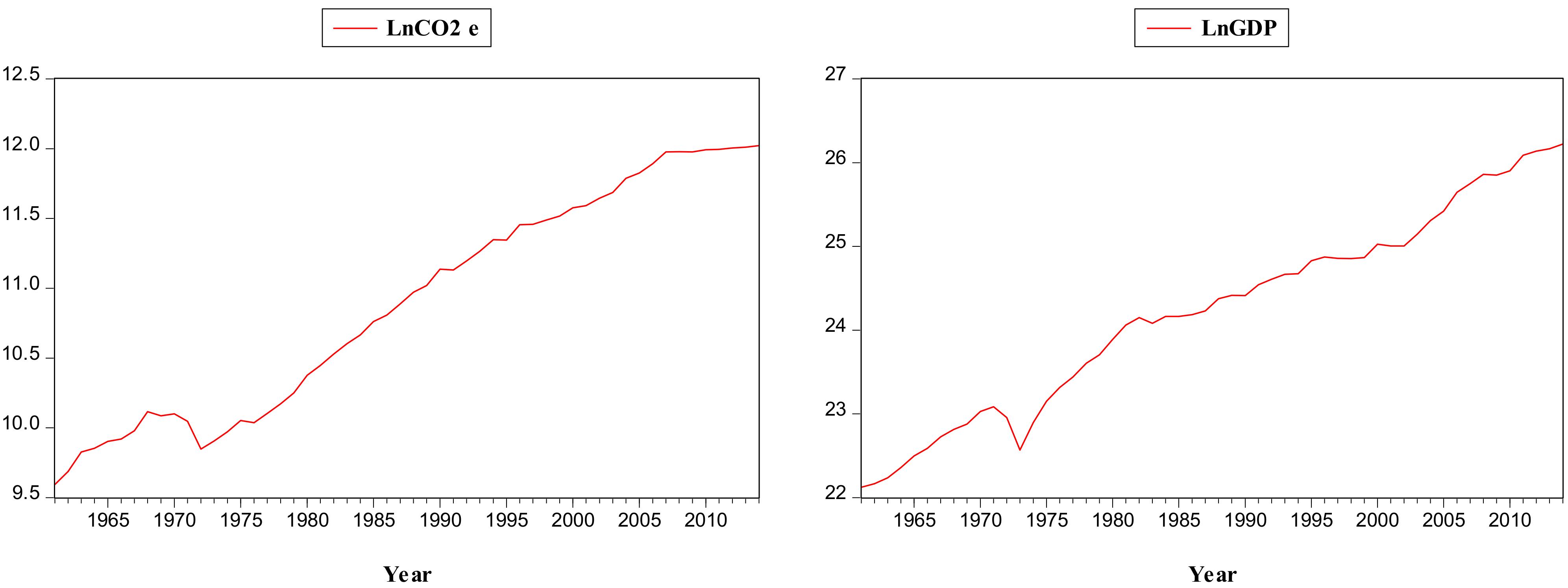
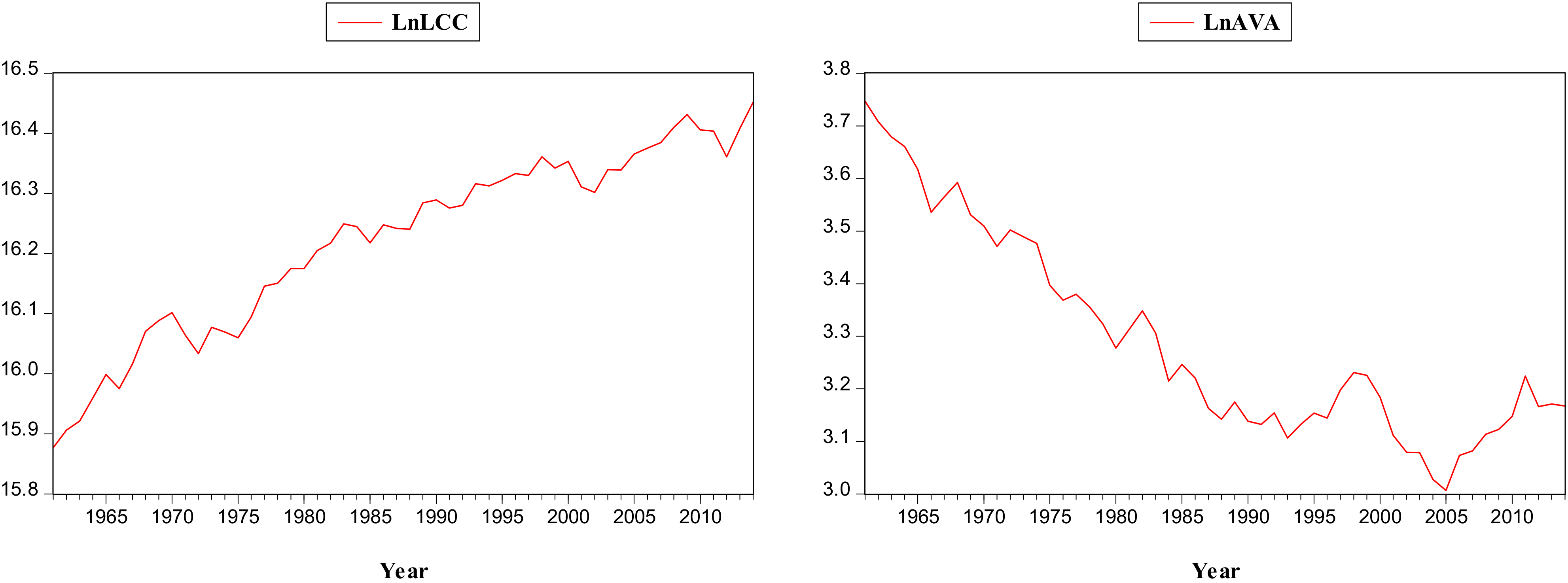
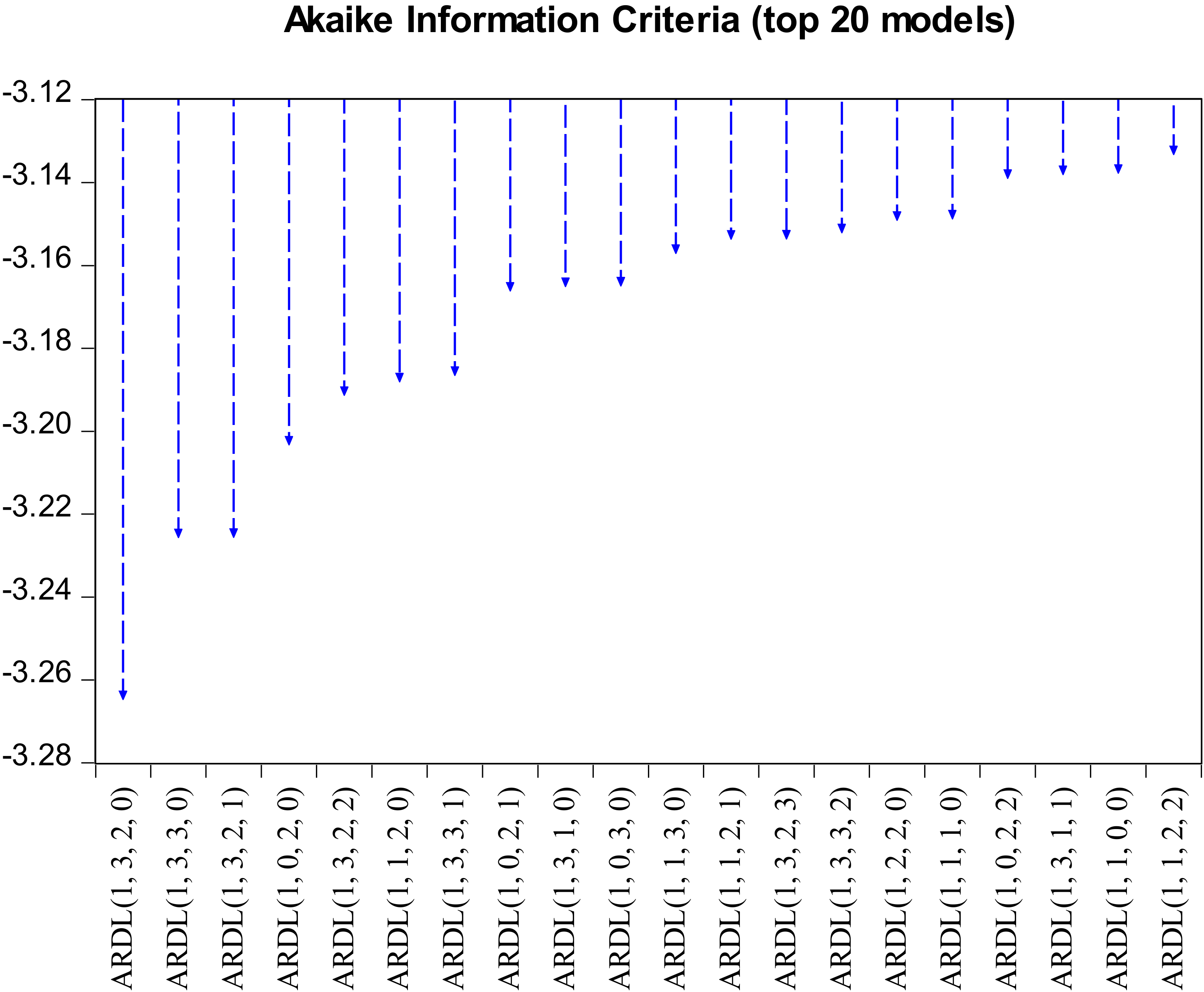
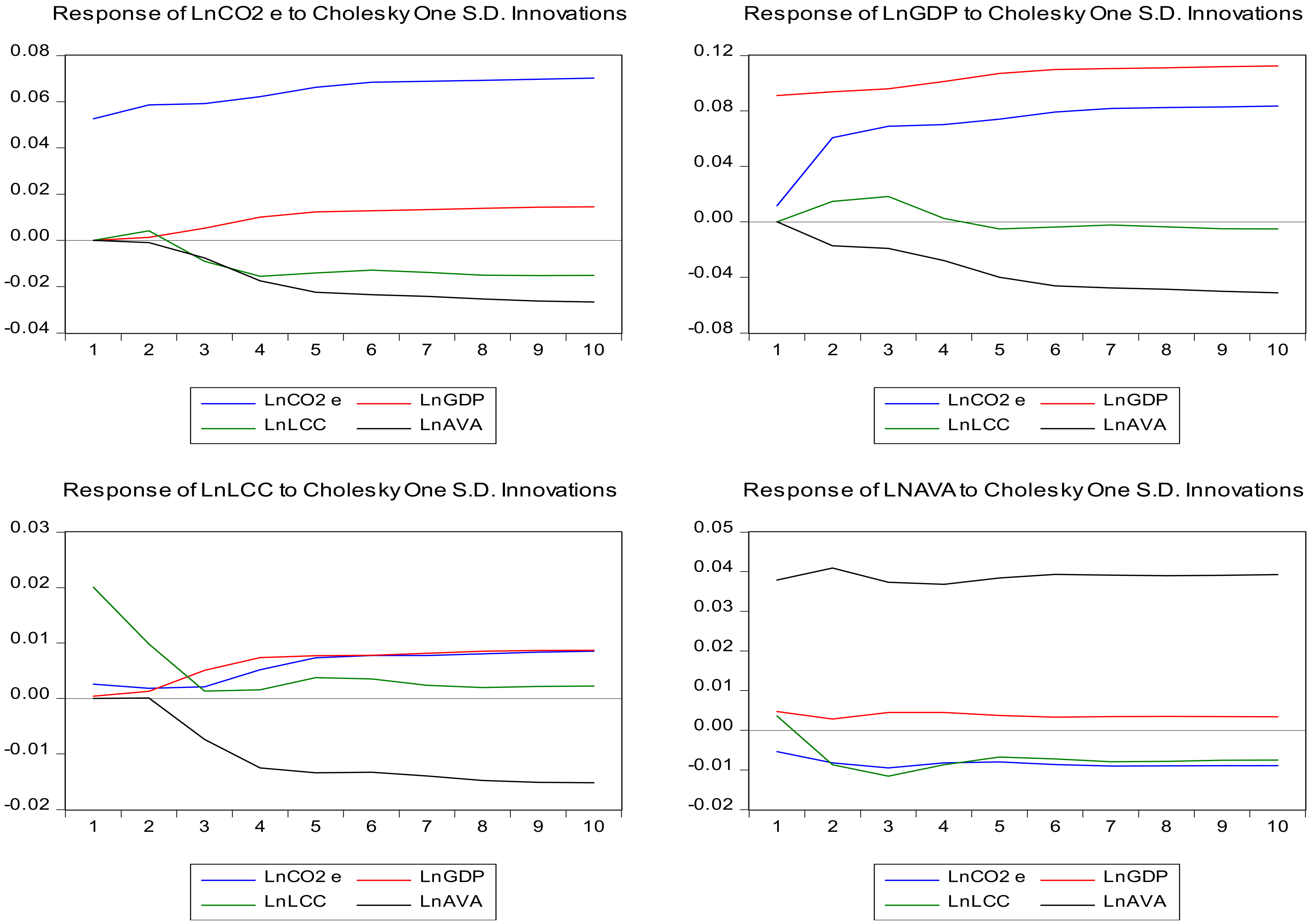
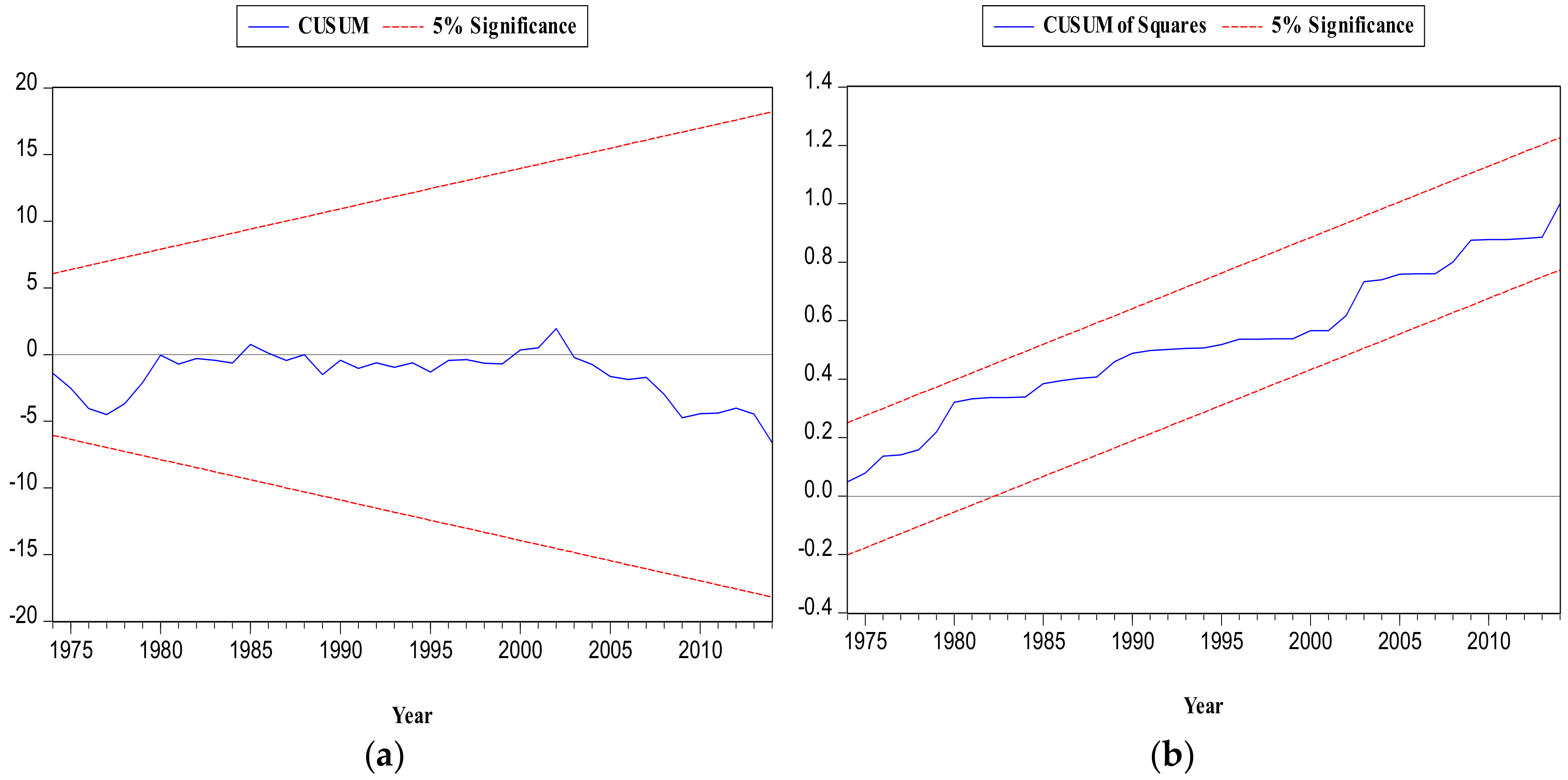
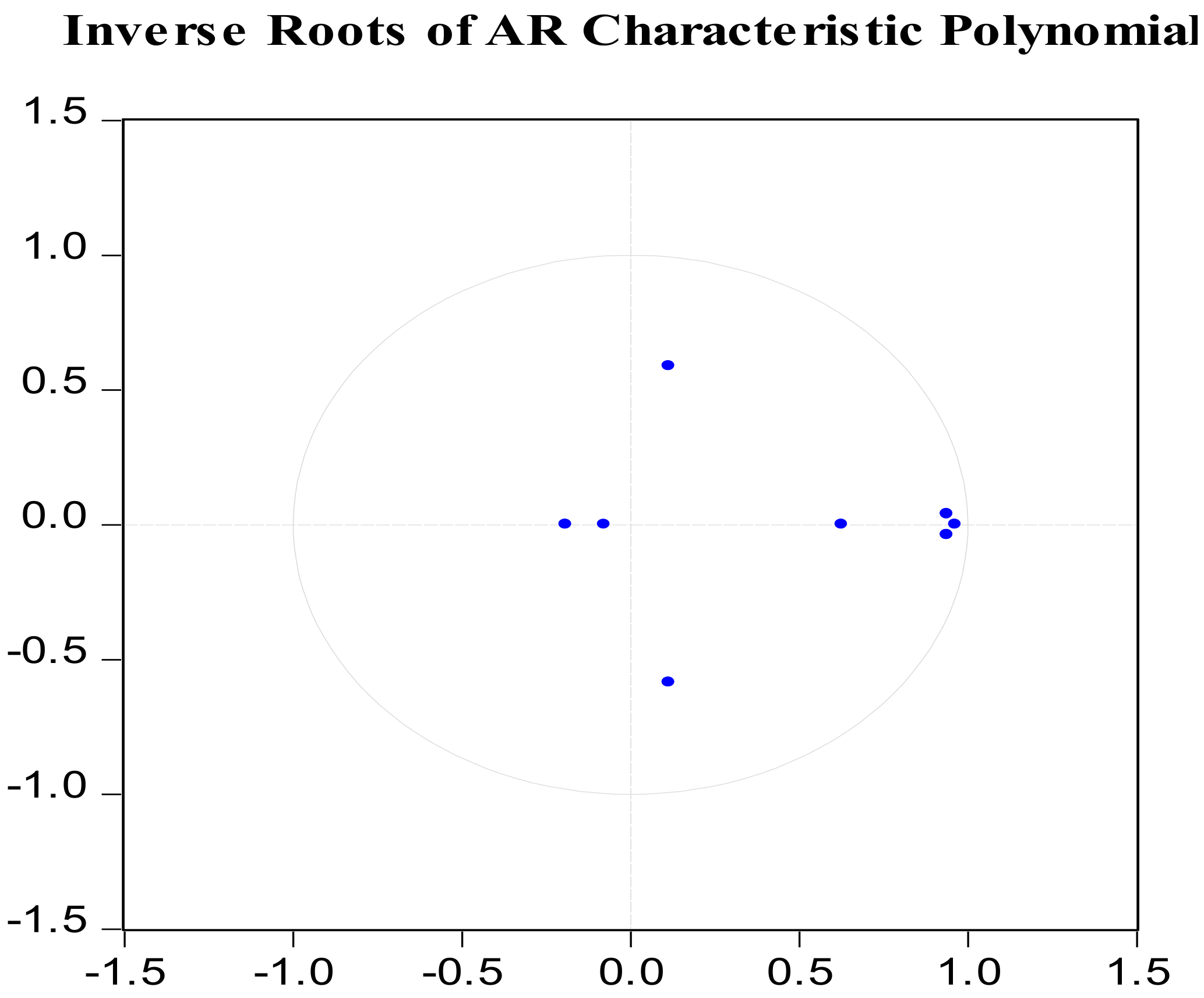
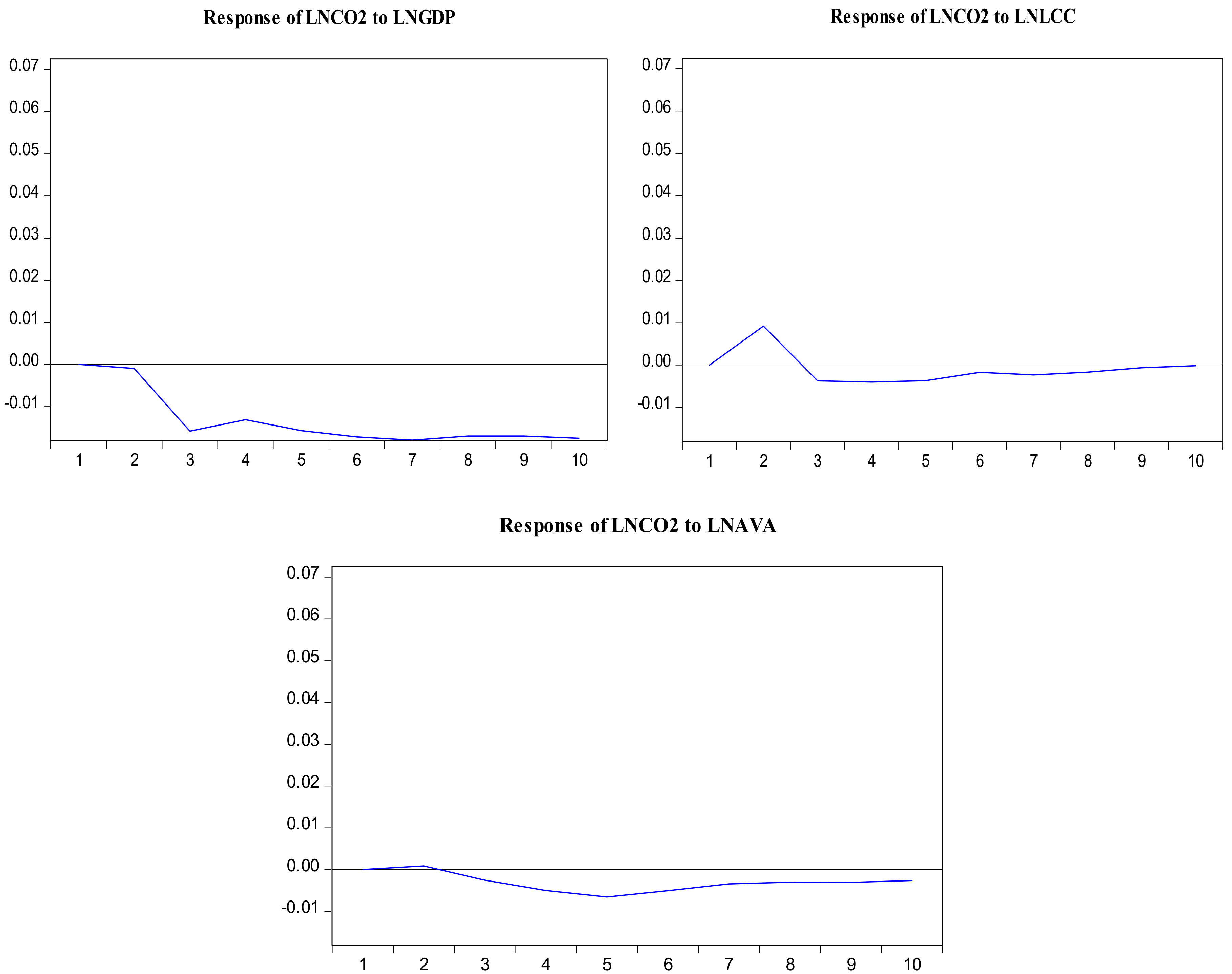
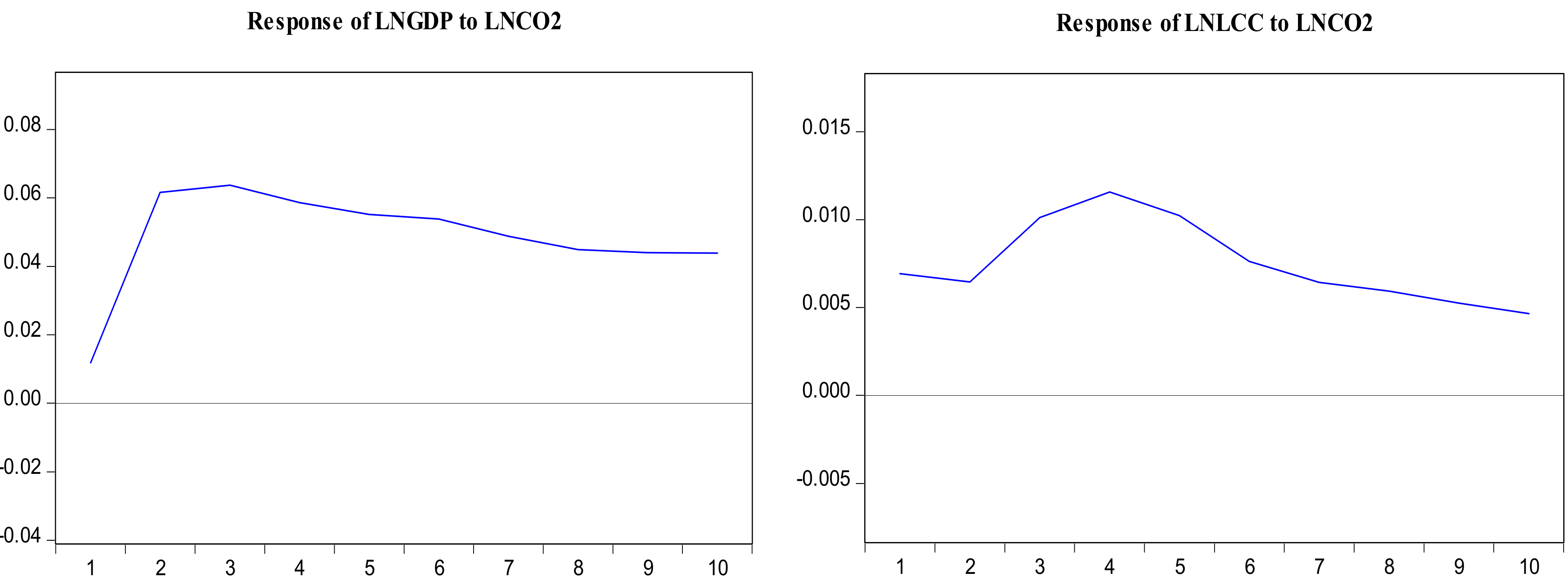
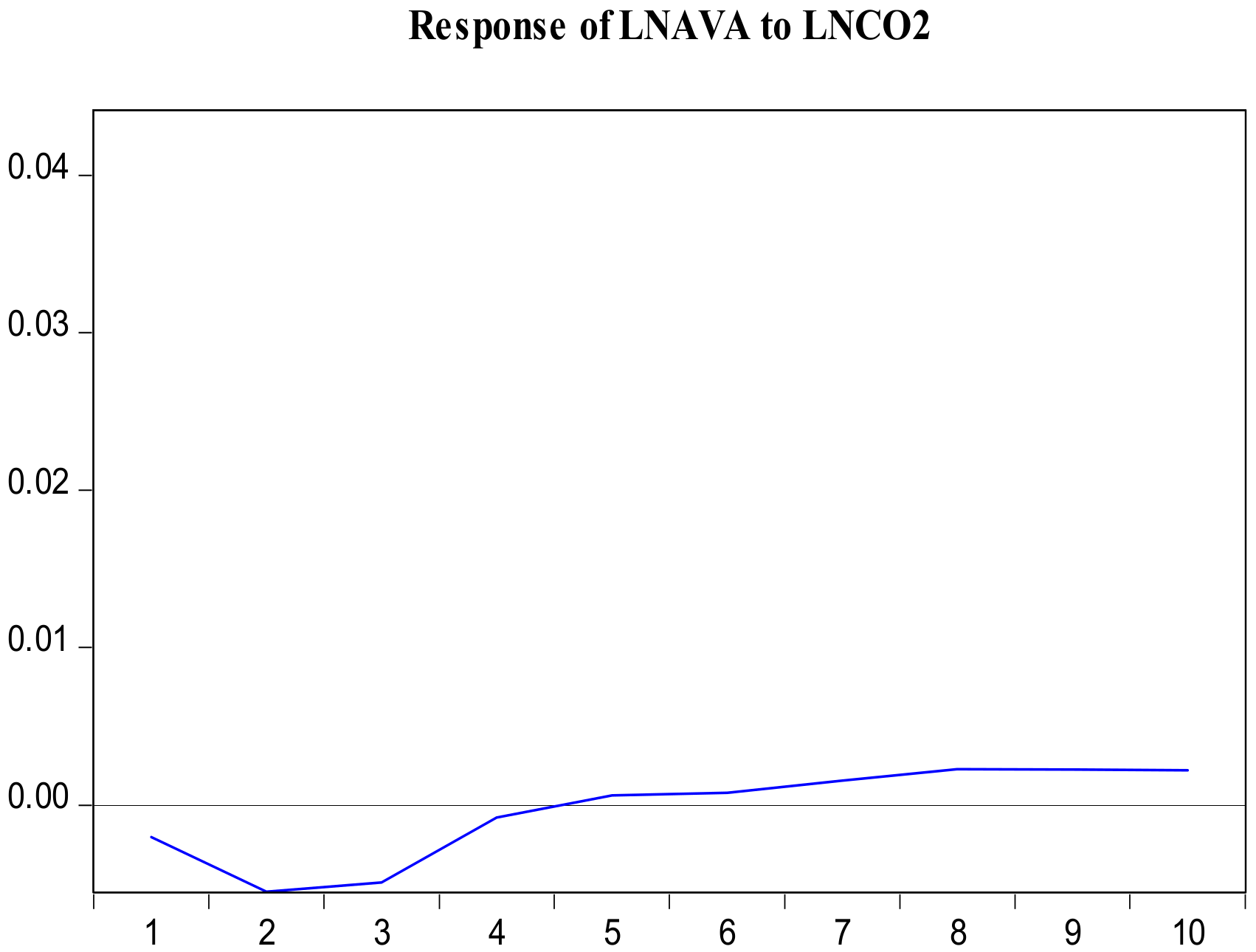
| Variable Name | Abbreviation | Unit of Measurement | Source |
|---|---|---|---|
| Carbon dioxide emission | CO2 e | Kilotons (kt) | FAOSTAT (2018) |
| Gross domestic product | GDP | Current US $ | WDI (2018) |
| Land under cereal crop | LCC | Hectares | WDI (2018) |
| Agriculture value added | AVA | Percentage of GDP | WDI (2018) |
| Variables | LnCO2 e | LnGDP | LnLCC | LnAVA |
| Mean | 10.88533 | 24.21358 | 16.22058 | 3.290421 |
| Median | 10.92998 | 24.30179 | 16.24839 | 3.222102 |
| Maximum | 12.02154 | 26.22191 | 16.45170 | 3.746831 |
| EMinimum | 9.592673 | 22.12312 | 15.87711 | 3.006656 |
| Std. Dev. | 0.801811 | 1.193248 | 0.152553 | 0.196416 |
| Skewness | 0.002686 | −0.087221 | −0.548516 | 0.734181 |
| Kurtosis | 1.510778 | 1.953711 | 2.226820 | 2.385217 |
| Jarque-Bera | 4.990073 | 2.531587 | 4.052896 | 5.701605 |
| Probability | 0.082493 | 0.282015 | 0.131803 | 0.057798 |
| Correlation | ||||
| LnCO2 e | 1.000000 | |||
| LnGDP | 0.978197 | 1.000000 | ||
| LnLCC | 0.956098 | 0.973567 | 1.000000 | |
| LnAVA | −0.884455 | −0.897413 | −0.930411 | 1.000000 |
| Lag | LogL | LR | FPE | AIC | SC | HQ |
|---|---|---|---|---|---|---|
| 0 | 112.9309 | NA | 1.51e–07 | −4.357238 | −4.204276 | −4.298989 |
| 1 | 346.9699 | 421.2700 | 2.46e–11 | −13.07879 | −12.31398* | −12.78755* |
| 2 | 366.4259 | 31.90793* | 2.17e–11* | −13.21704* | −11.84038 | −12.69280 |
| 3 | 380.8168 | 21.29858 | 2.39e–11 | −13.15267 | −11.16417 | −12.39544 |
| 4 | 395.6585 | 19.59104 | 2.67e–11 | −13.10634 | −10.50599 | −12.11611 |
| Variables | Akaike Info Criterion | Philips–Perron | ||||||
|---|---|---|---|---|---|---|---|---|
| LEVEL | 1ST DIFFERENCE | LEVEL | 1ST DIFFERENCE | |||||
| Intercept | Trend and Intercept | Intercept | Trend and Intercept | Intercept | Trend and Intercept | Intercept | Trend and Intercept | |
| LnCO2 e | −0.63771 0.8528 | −2.107644 0.5292 | −5.915923 0.0000 | −2.908476 0.1689 | −0.809440 0.8082 | −1.554595 0.7974 | −5.928838 0.0000 | −5.897317 0.0001 |
| LnGDP | −0.512237 0.8803 | −3.102790 0.1165 | −6.128411 0.0000 | −6.074545 0.0000 | −0.501008 0.8825 | −2.682416 0.2478 | −6.117041 0.0000 | −6.043380 0.0000 |
| LnLCC | −1.845078 0.3552 | −3.097552 0.1175 | −7.310103 0.0000 | −5.882637 0.0001 | −2.177064 0.2168 | −3.058810 0.1268 | −7.399540 0.0000 | −7.703130 0.0000 |
| LnAVA | −2.617304 0.0959 | −1.487037 0.8218 | −6.708506 0.0000 | −4.529780 0.0039 | −2.720270 0.0773 | −1.506937 0.8148 | −6.708506 0.0000 | −7.242419 0.0000 |
| Conclusion | Non-stationary | Stationary | Non-stationary | Stationary | ||||
| Hypothesized No. of CE(s) | Rank Test (Trace) | Rank Test (Maximum Eigenvalue) | |||||
|---|---|---|---|---|---|---|---|
| Eigenvalue | Trace Statistic | 0.05 Critical Value | Prob. | Max-Eigen Statistic | 0.05 Critical Value | Prob. | |
| None | 0.423351 | 52.89693 | 47.85613 | 0.0156 | 28.07661 | 27.58434 | 0.0432 |
| At most 1 | 0.300607 | 24.82032 | 29.79707 | 0.1679 | 18.23469 | 21.13162 | 0.1213 |
| At most 2 | 0.121100 | 6.585634 | 15.49471 | 0.6263 | 6.583293 | 14.26460 | 0.5395 |
| At most 3 | 0.0000459 | 0.002341 | 3.841466 | 0.9593 | 0.002341 | 3.841466 | 0.9593 |
| Test Statistic | Value | k |
|---|---|---|
| F-statistic | 5.805114 | 3 |
| Critical Value Bounds | ||
| Significance | I(0) Bound | I(1) Bound |
| 10% | 2.37 | 3.2 |
| 5% | 2.79 | 3.67 |
| 2.5% | 3.15 | 4,08 |
| 1% | 3.65 | 4.66 |
| Short Run Coefficients | ||||
| Variable | Coefficient | Std. Error | t-Statistic | Prob. |
| D(LnGDP) | 0.033643 | 0.056658 | 0.593784 | 0.5559 |
| D(LnGDP(−1)) | 0.014904 | 0.055969 | 0.266287 | 0.7914 |
| D(LnGDP(−2)) | −0.173688 | 0.058569 | −2.965542 | 0.0050 |
| D(LnLCC) | 0.863260 | 0.241211 | 3.578864 | 0.0009 |
| D(LnLCC(−1)) | 0.716364 | 0.243073 | 2.947112 | 0.0053 |
| ECT(−1) | −0.077780 | 0.013781 | −5.644230 | 0.0000 |
| Long Run Coefficients | ||||
| Variable | Coefficient | Std. Error | t-Statistic | Prob. |
| C | 1.496155 | 4.774608 | 0.313357 | 0.7556 |
| Ln CO2 e(−1) | −0.077780 | 0.038989 | −1.994952 | 0.0527 |
| LnGDP(−1) | 0.025249 | 0.042403 | 0.595470 | 0.5548 |
| LnLCC(−1) | −0.022297 | 0.326479 | −0.068295 | 0.9459 |
| LnAVA | −0.263688 | 0.097057 | −2.716831 | 0.0096 |
| D(LnGDP) | 0.033643 | 0.063982 | 0.525816 | 0.6018 |
| D(LnGDP(−1)) | 0.014904 | 0.065642 | 0.227049 | 0.8215 |
| D(LnGDP(−2)) | −0.173688 | 0.066271 | −2.620874 | 0.0122 |
| D(LnLCC) | 0.863260 | 0.298943 | 2.887709 | 0.0062 |
| D(LnLCC(−1)) | 0.716364 | 0.289813 | 2.471814 | 0.0177 |
| EC = LnCO2 e − (0.3246(LnGDP) − 0.2867(LnLCC) − 3.3902(LnAVA) + 19.2356)) | ||||
| Breusch-Godfrey Serial Correlation LM Test: | |
| F-statistic | 0.237056 |
| Obs R-squared | 0.936929 |
| Prob. F(3,38) | 0.8700 |
| Prob. Chi-Square(3) | 0.8165 |
| Heteroskedasticity Test: Breusch–Pagan–Godfrey | |
| F-statistic | 1.190498 |
| Obs R-squared | 10.56646 |
| Scaled explained SS | 10.87174 |
| Prob. F(9,41) | 0.3268 |
| Null Hypothesis: | Obs | F-Statistic | Prob. |
|---|---|---|---|
| LnGDP does not Granger Cause LnCO2 e | 52 | 0.34510 | 0.7099 |
| LnCO2 e does not Granger Cause LnGDP | 8.51829 | 0.0007 | |
| LnLCC does not Granger Cause LnCO2 e | 52 | 1.91090 | 0.1593 |
| LnCO2 e does not Granger Cause LnLCC | 1.81672 | 0.1738 | |
| LnAVA does not Granger Cause LnCO2 e | 52 | 2.63228 | 0.0825 |
| LnCO2 e does not Granger Cause LnAVA | 0.42783 | 0.6544 | |
| LnLCC does not Granger Cause LnGDP | 52 | 1.78823 | 0.1784 |
| LnGDP does not Granger Cause LnLCC | 6.22181 | 0.0040 | |
| LnAVA does not Granger Cause LnGDP | 52 | 1.03562 | 0.3630 |
| LnGDP does not Granger Cause LnAVA | 0.13864 | 0.8709 | |
| LnAVA does not Granger Cause LnLCC | 52 | 3.95660 | 0.0258 |
| LnLCC does not Granger Cause LnAVA | 1.43426 | 0.2485 | |
| Variance Decomposition of LnCO2 e: | |||||
| Period | S.E. | LNCO2 e | LnGDP | LnLCC | LnAVA |
| 1 | 0.052387 | 100.0000 | 0.000000 | 0.000000 | 0.000000 |
| 2 | 0.082091 | 98.71976 | 0.013097 | 1.256378 | 0.010761 |
| 3 | 0.110017 | 97.05350 | 2.074796 | 0.812947 | 0.058761 |
| 4 | 0.131880 | 96.72981 | 2.427748 | 0.658399 | 0.184048 |
| 5 | 0.151464 | 96.20375 | 2.913165 | 0.557815 | 0.325269 |
| 6 | 0.168350 | 95.78747 | 3.397230 | 0.461823 | 0.353472 |
| 7 | 0.183532 | 95.44742 | 3.816423 | 0.404535 | 0.331620 |
| 8 | 0.197549 | 95.30147 | 4.032265 | 0.356521 | 0.309743 |
| 9 | 0.210862 | 95.20442 | 4.188896 | 0.313796 | 0.292891 |
| 10 | 0.223536 | 95.10645 | 4.340165 | 0.279285 | 0.274097 |
| Variance Decomposition of LnGDP: | |||||
| Period | S.E. | LnCO2 e | LnGDP | LnLCC | LnAVA |
| 1 | 0.090540 | 1.714846 | 98.28515 | 0.000000 | 0.000000 |
| 2 | 0.147440 | 18.08957 | 79.94849 | 0.319798 | 1.642142 |
| 3 | 0.180273 | 24.58352 | 71.58001 | 0.872488 | 2.963985 |
| 4 | 0.202225 | 27.94786 | 67.03118 | 1.197606 | 3.823346 |
| 5 | 0.227024 | 28.07898 | 64.92696 | 1.894400 | 5.099661 |
| 6 | 0.250104 | 27.76311 | 63.32763 | 2.031381 | 6.877877 |
| 7 | 0.268642 | 27.36151 | 62.39127 | 2.146152 | 8.101068 |
| 8 | 0.285511 | 26.69581 | 62.00309 | 2.495791 | 8.805307 |
| 9 | 0.302657 | 25.87071 | 61.89515 | 2.792302 | 9.441847 |
| 10 | 0.319132 | 25.16367 | 61.79875 | 2.942672 | 10.09490 |
| Variance Decomposition of LnLCC: | |||||
| Period | S.E. | LnCO2 e | LnGDP | LnLCC | LnAVA |
| 1 | 0.019616 | 12.45762 | 0.679255 | 86.86313 | 0.000000 |
| 2 | 0.022818 | 17.21273 | 0.890578 | 78.32556 | 3.571125 |
| 3 | 0.025397 | 29.76056 | 3.976938 | 63.25735 | 3.005150 |
| 4 | 0.029421 | 37.65852 | 8.366014 | 47.75381 | 6.221656 |
| 5 | 0.032195 | 41.56618 | 7.848681 | 40.22046 | 10.36468 |
| 6 | 0.033756 | 42.90460 | 7.661578 | 36.78005 | 12.65377 |
| 7 | 0.035466 | 42.15718 | 8.493156 | 34.06056 | 15.28910 |
| 8 | 0.037344 | 40.54667 | 9.617245 | 31.05127 | 18.78481 |
| 9 | 0.038945 | 39.10538 | 10.27839 | 28.82381 | 21.79242 |
| 10 | 0.040393 | 37.68193 | 10.95538 | 27.30356 | 24.05913 |
| Variance Decomposition of LnAVA: | |||||
| Period | S.E. | LnCO2 e | LnGDP | LnLCC | LnAVA |
| 1 | 0.040325 | 0.255478 | 3.255885 | 4.319678 | 92.16896 |
| 2 | 0.060142 | 0.952231 | 1.551848 | 2.327764 | 95.16816 |
| 3 | 0.071323 | 1.153774 | 2.165245 | 2.590248 | 94.09073 |
| 4 | 0.081077 | 0.902385 | 2.715711 | 4.100540 | 92.28136 |
| 5 | 0.091163 | 0.718266 | 2.498629 | 5.149917 | 91.63319 |
| 6 | 0.100451 | 0.597671 | 2.267443 | 5.312943 | 91.82194 |
| 7 | 0.108566 | 0.532349 | 2.227840 | 5.480631 | 91.75918 |
| 8 | 0.116045 | 0.503706 | 2.175351 | 5.836543 | 91.48440 |
| 9 | 0.123284 | 0.479624 | 2.061993 | 6.111924 | 91.34646 |
| 10 | 0.130224 | 0.457998 | 1.967759 | 6.249748 | 91.32449 |
© 2019 by the authors. Licensee MDPI, Basel, Switzerland. This article is an open access article distributed under the terms and conditions of the Creative Commons Attribution (CC BY) license (http://creativecommons.org/licenses/by/4.0/).
Share and Cite
Ali, S.; Ying, L.; Shah, T.; Tariq, A.; Ali Chandio, A.; Ali, I. Analysis of the Nexus of CO2 Emissions, Economic Growth, Land under Cereal Crops and Agriculture Value-Added in Pakistan Using an ARDL Approach. Energies 2019, 12, 4590. https://doi.org/10.3390/en12234590
Ali S, Ying L, Shah T, Tariq A, Ali Chandio A, Ali I. Analysis of the Nexus of CO2 Emissions, Economic Growth, Land under Cereal Crops and Agriculture Value-Added in Pakistan Using an ARDL Approach. Energies. 2019; 12(23):4590. https://doi.org/10.3390/en12234590
Chicago/Turabian StyleAli, Sajjad, Liu Ying, Tariq Shah, Azam Tariq, Abbas Ali Chandio, and Ihsan Ali. 2019. "Analysis of the Nexus of CO2 Emissions, Economic Growth, Land under Cereal Crops and Agriculture Value-Added in Pakistan Using an ARDL Approach" Energies 12, no. 23: 4590. https://doi.org/10.3390/en12234590
APA StyleAli, S., Ying, L., Shah, T., Tariq, A., Ali Chandio, A., & Ali, I. (2019). Analysis of the Nexus of CO2 Emissions, Economic Growth, Land under Cereal Crops and Agriculture Value-Added in Pakistan Using an ARDL Approach. Energies, 12(23), 4590. https://doi.org/10.3390/en12234590






